
The RRS Discovery is a barque-rigged auxiliary steamship built for Antarctic research. Launched in 1901, she was the last traditional wooden three-masted ship to be built in the United Kingdom. Her first mission was the British National Antarctic Expedition, carrying Robert Falcon Scott and Ernest Shackleton on their first, and highly successful, journey to the Antarctic, known as the Discovery Expedition.

The Hecla class formed the backbone of the Royal Navy's ocean survey fleet from the mid-1960s.
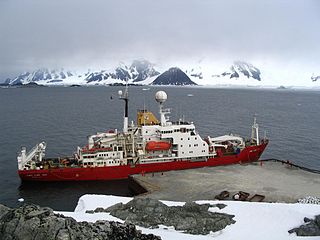
Noosfera is a polar supply and research ship operated by the National Antarctic Scientific Center of Ukraine. Until 2021, she was operated by the British Antarctic Survey and named RRS James Clark Ross.

A research vessel is a ship or boat designed, modified, or equipped to carry out research at sea. Research vessels carry out a number of roles. Some of these roles can be combined into a single vessel but others require a dedicated vessel. Due to the demanding nature of the work, research vessels may be constructed around an icebreaker hull, allowing them to operate in polar waters.

The National Oceanography Centre Southampton (NOCS) is a centre for research, teaching, and technology development in Ocean and Earth science. NOCS was created in 1995 jointly between the University of Southampton and the UK Natural Environment Research Council and is located within the port of Southampton at a purpose-built dockside campus with modern facilities. In 2010 the university and NERC components demerged, and the NERC-managed component became the National Oceanography Centre. The two components of NOCS continue close collaboration through the jointly run Graduate School, shared research facilities and laboratories, complementary research groups, and many joint research grants and publications. The university component “Ocean and Earth Science, National Oceanography Centre Southampton” (OES) is part of the Faculty of Environmental and Life Sciences, (FELS). It was ranked 46th in the world for Earth and Marine Sciences by the QS World University Rankings in 2019.
The National Oceanography Centre (NOC) is a marine science research and technology institution based on two sites in Southampton and Liverpool, United Kingdom. It is the UK’s largest institution for integrated sea level science, coastal and deep ocean research and technology development.
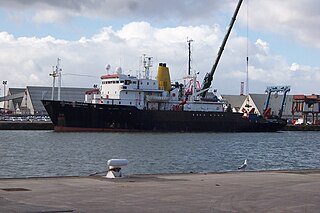
The RRS Charles Darwin was a Royal Research Ship belonging to the British Natural Environment Research Council. Since 2006, she has been the geophysical survey vessel, RV Ocean Researcher,
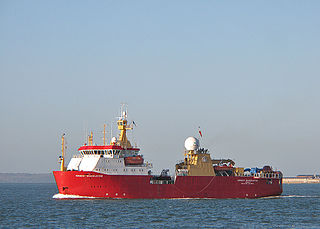
Laura Bassi is an icebreaking research vessel operated by the Italian National Institute for Oceanography and Applied Geophysics,. Between 1999 and 2019, she was the British Antarctic Survey (BAS) logistics ship, primarily used for the resupply of scientific stations in the Antarctic.
The British Antarctic Survey (BAS) is the United Kingdom's national polar research institute. It has a dual purpose, to conduct polar science, enabling better understanding of global issues, and to provide an active presence in the Antarctic on behalf of the UK. It is part of the Natural Environment Research Council (NERC). With over 400 staff, BAS takes an active role in Antarctic affairs, operating five research stations, one ship and five aircraft in both polar regions, as well as addressing key global and regional issues. This involves joint research projects with over 40 UK universities and more than 120 national and international collaborations.

The RRS James Cook is a British Royal Research Ship operated by the Natural Environment Research Council (NERC). She was built in 2006 to replace the ageing RRS Charles Darwin with funds from Britain's NERC and the DTI's Large Scientific Facilities Fund. She was named after Captain James Cook, the British explorer, navigator and cartographer at the National Oceanography Centre, Southampton by The Princess Royal.
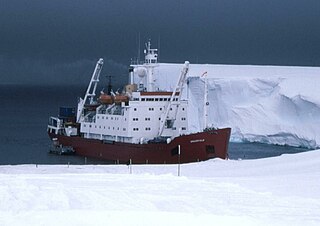
RRS Bransfield was an ice-strengthened cargo vessel, purpose-built for the British Antarctic Survey (BAS).
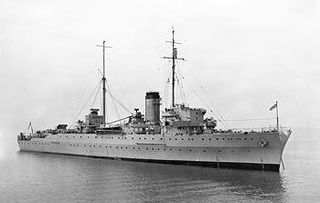
HMS Protector was an Antarctic patrol vessel of the Royal Navy between 1955 and 1968. She was built in 1935 as a net laying ship.
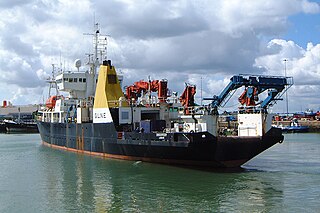
RRS Discovery was a British Royal Research Ship operated by NERC.

RRS Shackleton was a Royal Research Ship operated by the British scientific research organisations the Falkland Islands Dependencies Survey (FIDS), British Antarctic Survey (BAS) and Natural Environment Research Council (NERC) in the Antarctic from 1955 to 1983. She was subsequently operated as a seismic survey vessel under the names Geotek Beta, Profiler and finally Sea Profiler before being scrapped in 2011.

RRS William Scoresby was British Royal Research Ship built for operations in Antarctic waters. Specially built for the Discovery Committee by Cook, Welton & Gemmell of Beverley, the ship was launched on 31 December 1925, and named after the noted 19th-century Arctic explorer, scientist and clergyman. Over the next 12 years the ship made seven voyages into Antarctic waters as part of the Discovery Investigations, accompanied by the ship Discovery until 1929, and then by Discovery II. During this time she marked about 3,000 whales and completed biological, hydrographical and oceanographic studies. She also took part in the 2nd Wilkins-Hearst Antarctic Expedition in 1929-1930, launching a Lockheed Vega floatplane for flights over Antarctica.
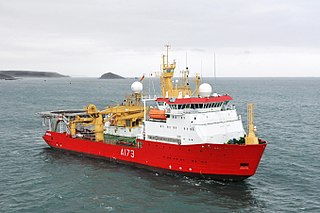
HMS Protector is a Royal Navy ice patrol ship built in Norway in mid 2000. As MV Polarbjørn she operated under charter as a polar research icebreaker and a subsea support vessel. In 2011, she was chartered as a temporary replacement for the ice patrol ship HMS Endurance and was purchased by the British Ministry of Defence in early September 2013. As DNV Ice Class 05 the vessel can handle first year ice up to 0.5 metres (20 in).
RRS Discovery II was a British Royal Research Ship which, during her operational lifetime of about 30 years, carried out considerable hydrographical and marine biological survey work in Antarctic waters and the Southern Ocean in the course of the Discovery Investigations research program. Built in Port Glasgow, launched in 1928 and completed in 1929, she was the first purpose-built oceanographic research vessel and was named after Robert Falcon Scott's 1901 ship, RRS Discovery.

RRS Discovery is a Royal Research Ship operated by the Natural Environment Research Council. The ship is the third such vessel to be built and named for the ship used by Robert Falcon Scott in his 1901-1904 expedition to the Antarctic.

Boaty McBoatface is the British lead boat in a fleet of three robotic lithium battery–powered autonomous underwater vehicles (AUVs) of the Autosub Long Range (ALR) class. Launched in 2017 and carried on board the polar scientific research vessel RRS Sir David Attenborough, she is a focal point of the Polar Explorer Programme of the UK Government.

RRS Sir David Attenborough is a research vessel owned by the Natural Environment Research Council and operated by the British Antarctic Survey for the purposes of both research and logistic support. The ship replaces a pair of existing vessels, RRS James Clark Ross and RRS Ernest Shackleton. The vessel is named after broadcaster and naturalist Sir David Attenborough.



















